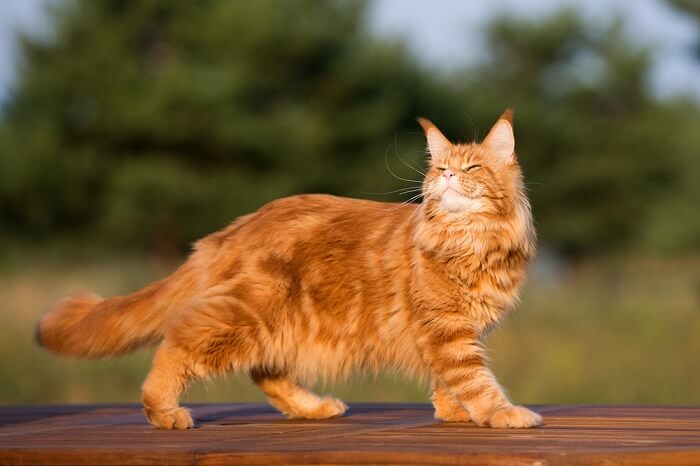
Aging cats experience a variety of health challenges. One such challenge is osteoarthritis which leads to stiff and sore joints, decreased mobility, less activity, and less time doing things that the cat would normally enjoy. Osteoarthritis (OA) is a term also known as arthritis or degenerative joint disease (DJD).
Quick Overview: Osteoarthritis in Cats






Osteoarthritis in Cats
Osteoarthritis, or arthritis, is a chronic condition that involves the degeneration, breaking down and thinning of cartilage within joints, formation of bone spurs, joint fluid buildup (effusion), thickening and scarring of connective tissues associated with the joint, and other changes to the bone around the joint.
Arthritis is a progressive, degenerative, and irreversible disease of the joints that causes decreased mobility and chronic pain. Basically, what happens is the normal cushioning of the joint wears away and causes pain and inflammation.
Arthritis can be caused by normal wear and tear on the joints in aging, but can also be secondary to injuries or trauma, excessive force, wear, or tear on the joints, poor joint alignment, or congenital orthopedic conditions.
While osteoarthritis is more commonly heard of in dogs, it is a condition that can also be seen in all ages, breeds, and sexes of cats. It is most commonly seen in older, overweight, or large-breed cats. According to International Cat Care (ICC), 90% of cats over 12 years of age, had evidence of arthritis.
The joints most commonly affected include the elbows, hips, and lower spine. However, cats’ knees (stifles), ankles (tarsi), and shoulders can also have arthritis. Many cats will have more than one joint with arthritis and commonly will have the same joint on both legs affected.
Symptoms of Osteoarthritis

The symptoms of osteoarthritis in cats can be subtle. They include reluctance to jump, running and playing less, and changes in your cat’s gait.
The signs of arthritis in cats may be less dramatic than in dogs. Cats are smaller and more agile than dogs, so they can compensate for pain and injuries more subtly.
Cats are very good at hiding their pain and discomfort so a cat owner might not be aware that their cat even has arthritis for some time before it is realized. The most common signs are lameness and decreased mobility.
You may see this as your cat not wanting to or able to jump up on furniture or in the window, less running and playing, laying around more, and changes in the cat’s gait like limping or walking slowly and stiffly.
Other signs include loss of muscle and strength, swollen joints, difficulty getting in & out of a litterbox, increased crankiness (due to pain), difficulty grooming (due to decreased mobility), or clicking and grinding of the joints.
Cats who have had previous injuries or who have been diagnosed with other orthopedic conditions such as hip dysplasia, will more commonly develop arthritis.
How Is Osteoarthritis Diagnosed?
Osteoarthritis is diagnosed by a veterinarian through a combination of history, physical examination, and imaging such as radiographs (X-rays). Sometimes, radiographic changes consistent with arthritis are found, but the cat might not be clinical for any issues or showing signs of pain.
According to the American College of Veterinary Surgeons (ACVS), changes on X-rays that show arthritis are seen in up to 90% of patients, while only about 50% of patients show signs of discomfort due to joint pain.
Treatment of Osteoarthritis
Arthritis is a condition that is more managed as opposed to treated. Once damage has been done in the joints, it is nearly impossible to regain normal structure and function.
The goal is the keep the cat comfortable by controlling pain and inflammation, improving mobility and function, and to reduce further damage. The approach to managing arthritis should be a multimodal approach, using several different therapies.
There is no single simple method to treat or prevent this condition.
Pain Management
The most commonly used pain medication for managing arthritis in cats are non-steroidal anti-inflammatory drugs (NSAIDS). These medications should only be prescribed by a veterinarian and over the counter medications should not be used as they can be toxic to cats.
The goal is to use the lowest effective dose, which often means adding in other methods of pain relief to decrease the frequency of dosing NSAIDS and to control their side effects.
Other pain medications that can be used to control pain due to arthritis, are analgesics such as Buprenorphine, Gabapentin, and Tramadol. These should also only be used under the direction of a veterinarian.
Joint Supplements
Joint supplements are an important addition to an arthritic cat’s treatment regimen. Some important ones to include are glucosamine hydrochloride which is a building block of the cartilage and helps cartilage cells grow, chondroitin sulfate which helps block enzymes that destroy cartilage, and fish oils that provide an important source of omega-3 fatty acids to decrease inflammation.
Some great glucosamine chondroitin supplements for cats are Cosequin and Dasuquin Advanced. Adequan is a polysulfated glycosaminoglycan that helps to control cartilage loss, lubricate, and decrease inflammation in joints.
Alternative Therapies
There are several therapies that are considered alternative, holistic, or complementary. These alternative therapies work well with other treatment methods for arthritis.
Acupuncture is a treatment where special needles are inserted at specific points on the body to stimulate pain relief and healing.
Cold laser therapy is a noninvasive way to encourage healing, provide pain relief, and decrease inflammation in affected joints.
Chiropractic adjustments can help restore normal function to the spine and body as a whole.
Massage can help relax sore and stiff muscles and increase blood flow.
Hydrotherapy involves a pool or under water treadmill to encourage mobility of joints, weight loss, and exercise while taking weight off of painful joints.
Stem cell therapy is a type of regenerative medicine to allow the body to repair and heal.
Environmental and Lifestyle Changes
Making some easy environmental changes for an arthritic cat will help with its overall quality of life and ability to get around easily and with comfort.
Bedding should be soft, cozy, and easily accessible. There should be comfortable places within easy reach for an arthritic cat to access. Ideally, have bedding in warm, dark, quiet places, away from noise and activity.
Provide ramps or steps to favorite perches such as furniture, beds, windows, cat trees, or other places your kitty likes to sit and spend time observing.
Use non-slip rugs or mats over hard floors where your cat likes to spend time. These will make it easier for the cat to grip and walk as opposed to slipping on hard slippery surfaces.
Restrict access to stairs and other places where your cat might try to jump up or down from.
Provide litter boxes in easily accessible areas and low sides. Some cats with arthritis may have a hard time climbing over tall edges to enter and exit a litter box. Make sure the cat can access them without the need for stairs or a long walk.
Make sure food and water bowls are easily accessible.
Help your kitty with grooming if they have a hard time reaching around to clean their back or underside. Don’t forget to trim their claws regularly to help with their grip as well.
Weight Management

Because excessive body weight puts a strain on the joints, weight management is an important part of managing osteoarthritis in cats.
It is very important to monitor an arthritic cat’s weight carefully and closely. Obesity increases the prevalence of arthritis in older cats. Overweight cats are prone to arthritis as excess weight puts a lot of pressure on sore joints. If the cat is overweight or obese, have your veterinarian help you with a weight loss program.
For overweight or obese cats, limit calories not only in regular meals but also in treats. Make sure diets are high in omega-3 fatty acids, low in carbs and fats, and high in protein and fiber. Choose a senior cat diet from a trusted brand that is meant for weight loss.
It is also important that your old kitty doesn’t lose too much weight. Older cats are also prone to weight and muscle loss so maintaining a balance is extremely important.
Regular controlled exercise is also important in maintaining your cat’s weight and muscle tone. Older arthritic cats are typically less active. Help your cat stay active by providing physical therapy, range of motion exercises, controlled and assisted exercise, or hydrotherapy. An inactive cat is prone to stiffness, soreness, and weight gain. Make sure to avoid strenuous exercise and don’t push a cat that is in pain – make sure pain is adequately controlled before starting an exercise regimen.
Surgery
Surgery of painful joints is sometimes indicated to remove bone spurs, smooth bone, and clean out diseased cartilage. Consult with your veterinarian to see if surgery is right for your arthritic cat.
Frequently Asked Questions
How is osteoarthritis treated in cats?
Osteoarthritis in cats is treated by managing clinical signs and symptoms of pain, helping to improve mobility and function, and decreasing further joint damage. This can be accomplished through anti-inflammatory medications, pain medications, supplements, alternative therapies, surgery, and more.
How long can cats live with arthritis?
Every cat is different when it comes to their prognosis and quality of life with a diagnosis of osteoarthritis. Working closely with your veterinarian is important in managing your cat’s arthritis. While there is no cure for arthritis, if the symptoms are managed appropriately, a cat can enjoy many years and a good quality of life with arthritis.
What can I do for my cat with arthritis?
Work with your veterinarian to develop a long-term management plan for your cat’s arthritis. Make environmental changes, manage your cat’s weight, provide pain control, and be attentive to subtle changes and needs of your arthritic cat.
At what age do cats get arthritis?
Cats can get arthritis at any age. In most studies of cats with osteoarthritis, the average age is over 10 years old. In one study published in 2002, 90% of cats over 12 years of age had evidence of arthritis.







